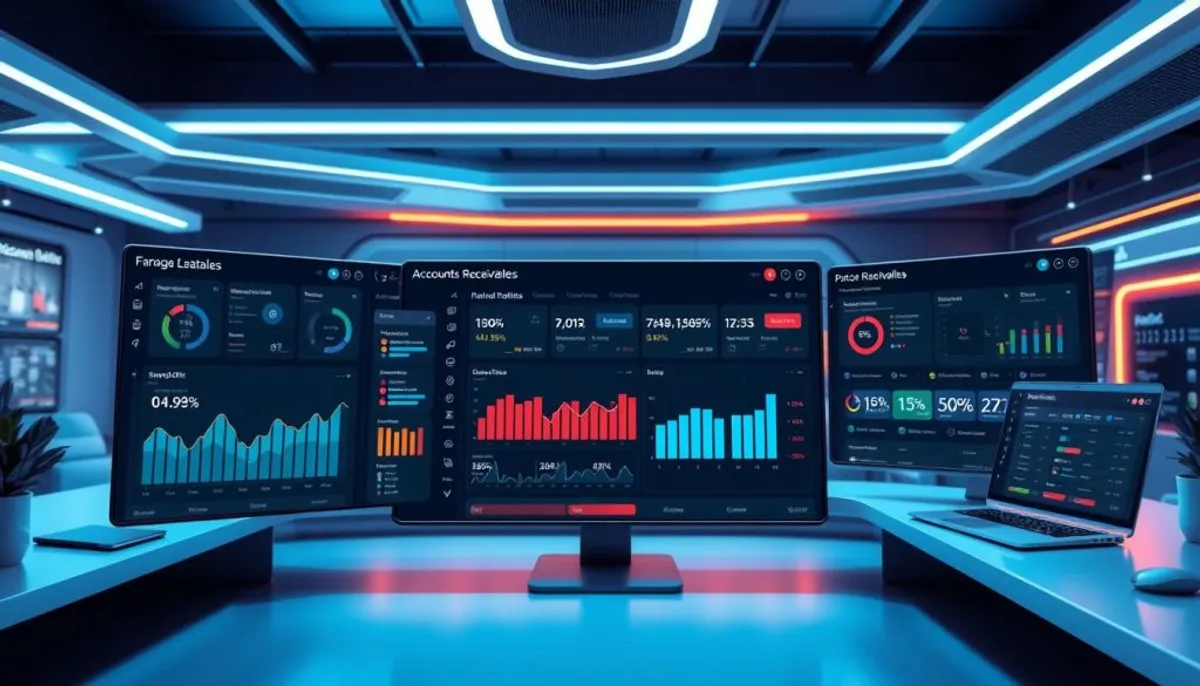Accounts receivables are fundamental to a company’s financial well-being, embodying the essence of money owed for goods or services extended on credit. For businesses, regardless of size, mastering accounts receivables is imperative. It ensures a steady cash flow, which is crucial for small enterprises aiming to flourish.
In the dynamic business landscape, the efficiency of accounts receivable processes can be a determining factor in a company’s success. From the inception of invoices to the collection of payments, each phase significantly influences a business’s financial health and its capacity to capitalize on market opportunities.

Effective management of accounts receivables hinges on the establishment of clear credit policies, the prompt issuance of invoices, and the proactive engagement with customers. By adopting best practices and utilizing contemporary tools, enterprises can optimize their accounts receivable workflows. This optimization leads to a decrease in late payments and enhances overall financial solidity.
Key Takeaways
- Accounts receivables are critical for business cash flow and financial health
- Efficient AR processes are essential for businesses of all sizes
- Clear credit policies and timely invoicing improve AR management
- Proactive customer communication helps reduce payment delays
- Leveraging AR software can streamline processes and improve accuracy
- Monitoring AR metrics helps identify and address potential issues
- Effective AR management contributes to overall business success
Understanding Accounts Receivables Fundamentals
Accounts receivable management is a pivotal component of business finance. It entails the tracking of funds owed by customers for credit-based transactions. This process is essential for ensuring a steady cash flow across various business scales.
Definition and Basic Concepts
Accounts receivable are classified as current assets on a company’s balance sheet. They signify funds owed by clients for goods or services rendered. These assets are anticipated to be received within a year, akin to cash and inventory.
The Role in Business Finance
Effective management of accounts receivable is critical for a company’s financial stability. It influences liquidity, enabling businesses to fulfill short-term obligations without additional cash inflows. The quicker a company can collect its receivables, the stronger its financial standing becomes.
Impact on Cash Flow Management
Accounts receivable significantly influence a company’s cash flow. Timely payment collection empowers businesses to seize market opportunities and execute growth strategies. Metrics such as Days Sales Outstanding (DSO) are pivotal in assessing collection efficiency and overall financial health.
| Metric | Description | Impact on Cash Flow |
|---|---|---|
| Days Sales Outstanding (DSO) | Average time to collect payments after a sale | Lower DSO indicates faster payment collection |
| Collections Effectiveness Index (CEI) | Comparison of owed vs. collected amounts | Higher CEI suggests better collection processes |
| Bad Debt Write-offs | Uncollectible funds | Higher write-offs negatively impact cash flow |
The Accounts Receivable Process Flow
The accounts receivable process is fundamental to a business’s financial health. It encompasses several critical steps aimed at ensuring a steady cash flow and fostering robust customer relationships. Let’s explore the essential components of this process.
Customer onboarding initiates the process, where payment terms are clearly defined. The subsequent step is invoice generation, a pivotal action that sets the stage for payment collection. Businesses swiftly dispatch invoices following the delivery of goods or services to their clients.
Tracking receivables is a subsequent, crucial phase. It involves diligent monitoring of due dates and the pursuit of overdue payments. Notably, 92% of B2B transactions still rely on paper checks, underscoring the necessity for effective tracking mechanisms.
Diverse payment collection strategies are employed. Buyers in the business sector leverage ACH, wire transfers, and credit cards among others. The efficient handling of these payments is paramount for maintaining precise financial records.
- Send invoices promptly
- Track due dates meticulously
- Follow up on late payments
- Process various payment methods
The culmination of the process is cash reconciliation, a critical step for financial reporting and regulatory compliance. This phase ensures that all payments received are accurately matched to their corresponding invoices within the accounting system.
Grasping and refining each phase of the accounts receivable process can markedly enhance a company’s financial standing and customer contentment.
Key Components of AR Management
Effective accounts receivable (AR) management is essential for maintaining a stable cash flow and financial health. By concentrating on key areas, businesses can optimize their AR processes. This leads to enhanced financial performance.
Credit Policy Development
A well-crafted credit policy is the cornerstone of successful AR management. It defines credit terms and conditions, guiding businesses in their credit extension decisions. Such policies mitigate the risk of late payments and bad debts, fostering a more stable cash flow.
Invoice Generation and Processing
Accurate and timely invoicing is critical for efficient payment collection. Businesses must create professional invoice templates with all required details. Automating the invoicing process can significantly enhance accuracy and minimize errors that might delay payments.
Payment Collection Strategies
Implementing effective payment collection strategies is crucial for maintaining a healthy cash flow. This involves sending regular reminders, offering diverse payment options, and addressing customer disputes promptly. By focusing on these strategies, businesses can decrease their Days Sales Outstanding (DSO) and enhance their Accounts Receivable Turnover Ratio.
Record Keeping Requirements
Proper AR documentation is vital for resolving disputes, supporting collection efforts, and ensuring auditing compliance. Detailed records of all transactions, communications, and payment histories are essential. They enable businesses to track AR performance and make informed decisions to refine their processes.
| AR Component | Impact on Business |
|---|---|
| Credit Policy | Reduces risk of late payments and bad debts |
| Invoice Accuracy | Facilitates prompt payments and reduces disputes |
| Collection Strategies | Improves cash flow and reduces DSO |
| Record Keeping | Supports dispute resolution and compliance |
By focusing on these key components, businesses can establish a robust AR management system. This system enhances financial stability and supports long-term growth.
Benefits of Effective AR Management
Effective accounts receivable (AR) management offers significant advantages to businesses. It is a pivotal factor in enhancing cash flow, ensuring financial stability, and facilitating growth. By optimizing AR processes, companies can notably decrease payment delays, thus maintaining a consistent flow of funds.
One of the primary benefits is the enhancement of financial health. Businesses with proficient AR management can make more informed decisions, allocate resources more effectively, and capitalize on growth opportunities. Let’s explore some key advantages:
- Improved liquidity and solvency
- Better operational efficiency
- Enhanced customer relationships
- Accurate revenue recognition
- Reduced bad debt

The effects of efficient AR management transcend financial realms. It offers valuable insights into sales trends and customer behaviors, aiding in strategic decision-making. Clear payment terms and automated processes expedite settlements and diminish disputes.
| AR Management Feature | Business Impact |
|---|---|
| Automated invoicing | Speeds up payment times |
| Online payment gateways | Facilitates quicker payments |
| Automated reminders | Reduces time chasing overdue accounts |
| Credit assessments | Mitigates risk of bad debts |
As the AR automation market is projected to expand by 13.3% by 2030, businesses increasingly appreciate its value. From e-commerce to SaaS companies, effective AR management is essential for maintaining financial health and driving growth across various sectors.
Common Challenges in Accounts Receivable Management
Businesses encounter numerous obstacles in managing accounts receivable. These hurdles can significantly affect financial stability and customer relationships. Let’s examine the primary issues that frequently trouble AR departments.
Late Payment Issues
Payment delays are a widespread problem for many companies. In fact, 98% of C-level executives report that upper management deals with invoice disputes and payment issues. Such delays strain business operations and can disrupt cash flow.
Bad Debt Management
Bad debt occurs when customers fail to or refuse to pay. This situation necessitates businesses to write off losses, affecting their bottom line. Effective cash flow management is critical in mitigating the impact of bad debt on overall financial health.
Cash Flow Disruptions
Inconsistent payment patterns and unexpected expenses can cause significant cash flow disruptions. 40% of finance leaders cite manual processes as the biggest challenge straining their ability to collect payments. This underscores the necessity for streamlined AR processes to maintain steady cash flow.
- Invoice errors due to manual data entry
- Transaction disputes leading to payment delays
- Forgotten payment reminders causing late settlements
Addressing these challenges promptly is essential for maintaining financial stability. Implementing automated AR solutions can help businesses overcome many of these hurdles. This approach reduces payment delays and enhances overall cash flow management.
AR Best Practices for Business Success
Effective accounts receivable (AR) strategies are pivotal for business success. By concentrating on key areas, companies can optimize their AR processes and enhance cash flow.
Setting Clear Payment Terms
Clear payment terms are fundamental for efficient AR operations. Businesses must establish and clearly communicate these terms from the outset to prevent misunderstandings. Offering incentives, such as early payment discounts, can motivate customers to pay promptly. For instance, a 2/10 net 30 policy provides a 2% discount for payments made within 10 days, with the full amount due in 30 days.
Customer Communication Strategies
Effective customer communication is essential for AR success. Regular, transparent updates on invoices and payment status are crucial for maintaining positive relationships. Timely reminders and follow-ups on overdue accounts can substantially decrease late payments. A survey revealed that 90% of customers value a seamless payment process for brand loyalty.
Documentation and Record Keeping
Proper AR documentation is critical for resolving disputes and audits. Accurate records of all transactions, communications, and payment histories are essential for efficient AR management. Automated AR systems can streamline this process, reducing errors and saving time. Studies indicate that businesses employing AR automation can reduce cash collection time by up to 80%.
By adopting these best practices, businesses can refine their AR processes, boost cash flow, and foster stronger customer relationships. Regularly reviewing and updating AR policies ensures continued effectiveness in a dynamic business environment.
Accounts Receivable Automation Solutions
AR automation is transforming the management of accounts receivable processes for businesses. Modern accounts receivable software equips companies with advanced tools to streamline operations and enhance AR efficiency. These solutions address common challenges in AR management, such as the time-consuming nature of manual tasks and the issue of payment delays.
- Cost savings of over 70% in invoicing expenses
- Elimination of 100% of lockbox data capture fees
- Reduction in time spent on routine tasks
- Enhanced operational efficiency for accounting teams
- Improved process accuracy by eliminating human errors
Accounts receivable software provides real-time visibility into invoice status and receivables. It utilizes AI for predicting payment dates and segmenting customers. These functionalities empower businesses to make informed decisions and refine their AR strategies.
| AR Process | Manual Approach | Automated Approach |
|---|---|---|
| Invoice Generation | Time-consuming, error-prone | Quick, accurate, automated |
| Payment Reminders | Inconsistent, labor-intensive | Automated emails, SMS, customer portals |
| Cash Application | Slow, prone to mistakes | Fast, accurate, automated matching |
| Reporting | Time-consuming, limited insights | Real-time analytics, comprehensive reports |
By embracing AR automation solutions, businesses can significantly improve their cash flow and reduce Days Sales Outstanding (DSO). These tools strike a balance between automation and human interaction, effectively managing payment collection and addressing customer concerns.
Introducing ti3: Modern AR Management Platform
The ti3 platform is a game-changer for accounts receivable management in businesses. It addresses common AR challenges, making processes smoother and more efficient.
Platform Features and Benefits
Ti3 comes equipped with various tools to enhance AR operations. Its intuitive interface simplifies invoice creation and tracking. Automated reminders also play a crucial role, cutting down on late payments and enhancing cash flow.
With ti3, businesses can foster stronger client relationships while achieving superior collection outcomes.

Automation Capabilities
At the heart of ti3 lies AR automation. It significantly reduces invoice processing time and error rates. This efficiency leads to substantial cost savings, with electronic invoices cutting down on paper, printing, and mailing expenses by 60-80%.
Automated invoicing also accelerates payments, addressing the common issue of SMEs waiting over two months for overdue invoices.
Integration Options
Ti3 integrates seamlessly with existing financial systems, offering a comprehensive AR management solution. This integration streamlines invoicing and payment tracking, reducing manual errors and saving time. The platform’s online payment portals expedite invoice payments, providing various options for clients.
By adopting ti3’s technology-driven invoice management, businesses are 8 times more likely to receive payments on time, significantly improving their financial health.
- Reduces manual invoice processing costs
- Improves payment collection efficiency
- Offers real-time visibility into AR status
- Enhances customer communication
AR Metrics and Performance Indicators
AR metrics are essential for assessing the success of receivables management strategies. They provide insights into a company’s financial health and guide improvements in collection processes.
Days Sales Outstanding (DSO)
DSO gauges the time elapsed between a sale and payment receipt. It’s computed as (Accounts Receivable ÷ Total Net Credit Sales) × Number of Days in Period. Ideally, DSO should remain under 45 days, though this threshold can differ by industry. Reducing DSO enhances cash flow and working capital.
Collection Effectiveness Index
The Collection Effectiveness Index (CEI) evaluates the efficacy of collection efforts. A CEI exceeding 80% signifies commendable performance. This metric aids in pinpointing collection process enhancements and devising strategies to diminish past-due accounts.
Accounts Receivable Turnover Ratio
The AR turnover ratio reflects the swiftness of payment collection. It’s calculated as Net Credit Sales ÷ Average Accounts Receivable. A higher ratio signifies more efficient collections and superior cash flow management.
| AR Metric | Formula | Target Range |
|---|---|---|
| Days Sales Outstanding (DSO) | (AR ÷ Net Credit Sales) × Days in Period | Below 45 days |
| Collection Effectiveness Index (CEI) | (Total Collections ÷ Total Receivables) × 100 | Above 80% |
| AR Turnover Ratio | Net Credit Sales ÷ Average AR | Higher is better |
Regularly tracking these AR metrics empowers businesses to make informed decisions. This leads to better receivables management, improved cash flow, and sustained financial health.
AR Risk Management Strategies
Effective AR risk management is crucial for businesses to minimize potential losses from unpaid invoices. By implementing smart strategies, companies can protect their cash flow and ensure financial stability.
Credit risk assessment is a key component of AR management. Conducting thorough credit checks on new customers can decrease the risk of payment defaults by 30%. Setting appropriate credit limits based on these assessments helps maintain a healthy balance between sales growth and financial security.
Diversifying the customer base is an essential risk mitigation tactic. This approach spreads the credit risk across multiple clients, reducing the impact of any single customer’s payment issues. Small businesses often face challenges due to unpaid invoices, with nearly a quarter of their monthly revenue tied up in outstanding payments.
AR insurance is gaining popularity as a protective measure against significant losses. This financial tool safeguards businesses from potential defaults, specially when dealing with large accounts or high-risk customers.
| Strategy | Impact |
|---|---|
| Clear credit policies | Reduce outstanding receivables by 40% |
| Timely invoicing | Improve on-time payments by 25% |
| Multiple payment options | Increase prompt settlements by 20% |
| Regular account monitoring | Reduce overdue accounts by 15% |
Regular review and adjustment of credit policies based on market conditions and customer performance are vital. This proactive approach helps businesses maintain a healthy AR portfolio and minimize financial risks. With 82% of small businesses failing due to poor cash flow management, implementing these strategies is not just beneficial—it’s essential for long-term success.
Future Trends in Accounts Receivables
The landscape of accounts receivable is undergoing a transformative shift. Businesses are integrating new technologies to enhance efficiency and streamline processes. This evolution is pivotal, as it shapes the future of AR management.
Digital Transformation
AR digital transformation is revolutionizing the handling of receivables. Cloud-based solutions and mobile accessibility are redefining how companies manage their AR processes remotely. This transformation is essential, with 62% of companies planning to upgrade their AR technology in 2024.
AI and Machine Learning Applications
AI in accounts receivable is increasingly prominent. These technologies are refining predictive analytics for credit risk assessment and optimizing collection strategies. AI automates tasks such as data entry and risk assessments, reducing errors and streamlining workflows. Notably, 91% of mid-sized firms with fully automated AR systems report increased savings, cash flow, and growth.
Emerging Payment Technologies
Blockchain payments are gaining momentum in the AR sector. This technology ensures secure, transparent, and rapid transactions. Real-time payments are also transforming payment receipt and processing, enhancing cash flow management by reducing delays.
| Trend | Impact | Adoption Rate |
|---|---|---|
| AR Digital Transformation | Streamlined processes | 62% plan to upgrade in 2024 |
| AI in Accounts Receivable | Enhanced efficiency | 91% of automated firms see benefits |
| Blockchain Payments | Faster, secure transactions | Growing adoption |
These trends promise to further automate AR processes, improve accuracy, and offer deeper insights for strategic decision-making. As businesses adapt to these advancements, they will be more adept at navigating the complexities of modern finance management.
Conclusion
In today’s fast-paced business world, the significance of AR management is paramount. It forms the bedrock of a company’s financial health. By adopting automated invoicing and a variety of payment methods, businesses can notably boost their cash flow. This, in turn, leads to a reduction in processing costs.
The role of data-driven decision-making is evident through metrics like Days Sales Outstanding (DSO) and Accounts Receivable Turnover Ratio. These metrics offer crucial insights into a company’s financial standing and creditworthiness. By utilizing these metrics, businesses can refine their AR processes. This results in enhanced liquidity and stronger ties with customers.
Looking ahead, technology’s influence on AR management will intensify. Innovations like ti3 are transforming the sector, offering significant time and cost savings. By embracing these technologies and maintaining a proactive stance towards AR management, companies can fortify their financial position. This sets the stage for sustainable growth in a constantly changing market.
RelatedRelated articles



